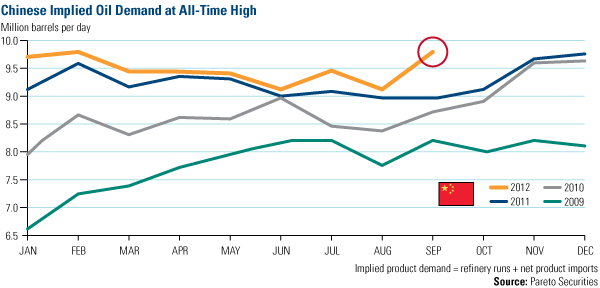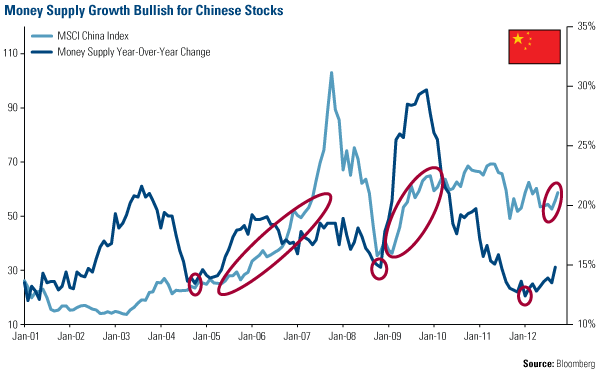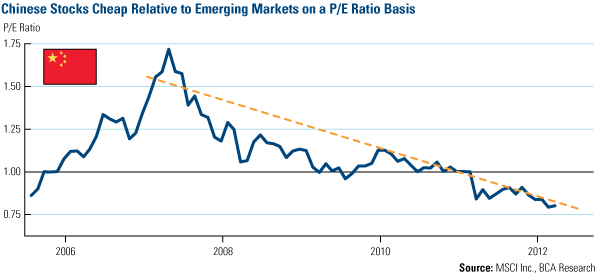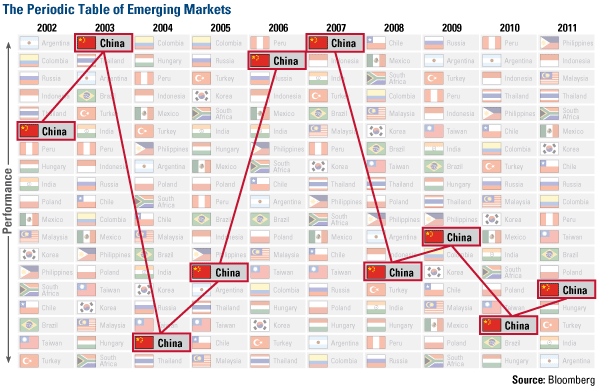With negative sentiment toward China reaching an extreme in recent months, patient investors have been rewarded with this week’s news of improving data from the Asian giant. [In fact, according to BCA] this appears to be a good time to be investing in China, as stocks are historically cheap. Words: 760
patient investors have been rewarded with this week’s news of improving data from the Asian giant. [In fact, according to BCA] this appears to be a good time to be investing in China, as stocks are historically cheap. Words: 760
So says Frank Holmes, CEO and Chief Investment Officer of U.S. Global Investors(www.usfunds.com) in edited excerpts from his original article* posted under the title Chinese Stocks Looking Like a Bargain.
Lorimer Wilson, editor of www.FinancialArticleSummariesToday.com (A site for sore eyes and inquisitive minds) and www.munKNEE.com (Your Key to Making Money!), has edited the article below for length and clarity – see Editor’s Note at the bottom of the page. This paragraph must be included in any article re-posting to avoid copyright infringement.
Holmes goes on to say, in part:
Retail Sales, Disposable Income and Export Numbers
CLSA Sinology’s Andy Rothman reported that in September:
- retail sales growth rose 13.2 percent, which was the fastest pace of the year,
- real urban disposable income grew nearly 10 percent and
- real rural disposable income rose more than 12 percent during the first three quarters of the year and,
- while export numbers are weak, China has so far avoided the large-scale export-sector layoffs that led to 2009’s massive stimulus.
Commodity Imports
There was strength in commodity imports, too.
- Copper imports into China increased 11 percent compared to the previous month due to increased demand from power infrastructure, white goods restocking and auto production.
- Iron ore rose a modest 4 percent compared to the previous month, which is encouraging.
- There was also a sharp rebound in oil imports most likely due to holiday restocking and lower international prices. In fact, Pareto Securities found that Chinese implied oil demand came in at an all-time high of 9.8 million barrels per day in September.

Fixed Asset Investment
The markets also saw an increase in fixed asset investment (FAI), a measure of capital spending, which grew at “the fastest pace since October 2011,” says CLSA. According to Credit Suisse, “a surge in transportation spending in the month of September is starting to reflect the project approvals for highway, rail, airport, and metropolitan transport projects announced in May and June.”
While Credit Suisse says FAI growth was boosted by government investment stimulus, CLSA also notes that fixed asset investment and capital spending by private firms has been rising faster than state-owned firms for 30 of the last 31 months.
Don’t Delay!
– Go here to receive Your Daily Intelligence Report with links to the latest articles posted on munKNEE.com
– It’s FREE and includes an “easy unsubscribe feature” should you decide to do so at any time
– Join the informed! 100,000+ articles are read every month at munKNEE.com
– All articles are posted in edited form for the sake of clarity and brevity to ensure a fast and easy read
– Get newly posted articles delivered automatically to your inbox
– Sign up here
Money Supply
Money supply, a key lubricant of the economy and markets, also continued to increase, and this has historically driven Chinese equities. Take a look at the chart below, which shows the year-over-year money supply compared to the MSCI China Index over the past decade. Over the past 10 years, after the supply in money bottomed, stocks soon rebounded.
On January 31, 2012, money supply hit a near decade low of 12.4 percent year-over-year growth. Since then, the number has been creeping higher, rising sharply to 14.8 percent in September, and shortly thereafter, equities responded.

Stock Prices & Investor Sentiment
The Wall Street Journal recognized the improvement in Asian stocks and investor sentiment this week, suggesting that the “region’s economy could be nearing the end of a slowdown” and that “if the Chinese economy shows sustained signs of stabilizing, it would remove a major overhang of worry for investors in Asia, and may spur more capital raising and other deals as investors become confident enough to switch money out of bonds and back into equity markets.”
Who in the world is currently reading this article along with you? Click here
This appears to be a good time to be investing in China, as stocks are historically cheap. At the beginning of October, BCA noted that there was a “prevailing pessimism” around China and that the stocks were “currently trading at hefty discounts to world averages and even to euro zone stocks.” The firm indicated that Chinese shares had a forward price-to-earnings ratio of below 9 times; the world and U.S. benchmarks traded at 12 and 13 times, respectively.
Chinese stocks are also cheap compared to emerging markets. In 2007, China traded at a 75 percent premium to emerging markets. Today, Chinese stocks trade at a 20 percent discount. If you look at a comparison of price-to-earnings in China to those in emerging markets, you have to go back to 2006 to find that ratio as low as it is today.

The low price-to-earnings indicates to me that the negativity pendulum has swung too far. “Investors have turned from euphoria at the height of the ‘China mania’ five years ago to extreme pessimism,” says BCA.
Conclusion
Back in April, I listed three trends that global investors should watch in China: A rebound in the liquidity cycle signaling a rally in equity prices, a new leadership with an incentive to maintain growth, and Chinese stocks reverting to their mean, as history appears to favor Chinese stocks landing in the top half of emerging markets [see table below].

Time will tell.
*http://www.usfunds.com/media/files/pdfs/investor-alert/-2012-ia/2012-10-19/Investor-Alert_10-19-2012.pdf
Editor’s Note: The above post may have been edited ([ ]), abridged (…), and reformatted (including the title, some sub-titles and bold/italics emphases) for the sake of clarity and brevity to ensure a fast and easy read. The article’s views and conclusions are unaltered and no personal comments have been included to maintain the integrity of the original article.
Related Articles:
1. The China Syndrome – Fully Understanding China’s Economic Prospects: Michael Pettis
In order to argue that we will not see a sharp slowdown in Chinese growth, it is not enough to claim that a) some expert or institution has predicted that Chinese growth will not slowdown, b)that China has enough savings in its coffers to bail itself out of a crisis or c) that Beijing leaders cannot tolerate growth below 8%, so of course growth will not drop below 8%. As greater evidence for the bear camp surfaces, China bulls need stronger justifications for their positions or risk losing credibility. [In fact, they need precise answers to 3 questions put forth in this lengthy but extremely insightful (dare I say, absolute best, article on the China sydrome to have ever been written!) article. Words: 4130
2. The Rationale for Investing in China Now Instead of the U.S. or Europe Is…..
I believe that the engine of global economic growth for the next five-year period will be China. I firmly also believe that it’s not only appropriate, but critical for investors, even those whose focus is trading rather than investing to now take a look at China equities based on long-term investment horizons. [This article does just that with some specific investment suggestions.] Words: 1581
 munKNEE.com Your Key to Making Money
munKNEE.com Your Key to Making Money
